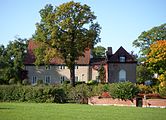Djursholm
This article needs additional citations for verification. (November 2013) |
Djursholm | |
|---|---|
 | |
| Country | Sweden |
| Municipality | Danderyd Municipality |
| County | Stockholm County |
| Province | Uppland |
| Charter | 1901 |
| Time zone | UTC+1 (CET) |
| • Summer (DST) | UTC+2 (CEST) |
Djursholm (Swedish pronunciation: [jɵʂˈhɔlm]) is one of four suburban districts in, and the seat of Danderyd Municipality, Stockholm County, Sweden. Djursholm is included in the multi-municipal Stockholm urban area. Djursholm is divided into a number of different areas - Djursholms Ekeby (northwest), Svalnäs (northeast), Ösby (central), Berga (southwest) and Gamla Djursholm ('Old Djursholm', southeast).
History
Djursholm was one of the first suburban communities in Sweden, its history as such beginning in 1889 with the founding of Djursholm AB (Djursholm Inc.) by Henrik Palme and the subsequent 1890 inauguration of the railway line connecting Djursholm to Stockholm, Djursholmsbanan. Since 1895 it has been served by electric suburban trains but the original branch was closed in 1975.
Djursholm is the wealthiest community in Sweden, with the most expensive property prices in the country.[citation needed] It was built as a garden city with large villas, most from the turn of the century, along winding roads. Already from start the elegant seaside quarters attracted many well known academics, cultural personalities and industrialists.
Djursholm was separated from Danderyd as a municipality of its own in 1901, becoming a city (Djursholms stad) in 1914. In 1971 it was reunited with Danderyd when the present municipality was created. Statistically Djursholm lies within the Stockholm urban area.
Sights
- Djursholm Castle. The original stone building was likely erected by Nils Eskilsson Banér in the 15th century. Svante Gustavsson Banér commissioned a refurbishment of the castle to its current form in the 16th century
- Djursholm Chapel. Completed in 1902 on the initiative of Fredrik Lilljekvist, who was also the architect. The ornate altar paintings are by Natanael Beskow, who was the resident vicar at the time.
- Villa Pauli. Large villa on Strandvägen in central Djursholm, designed by Ragnar Östberg and completed in 1907. Since 1986, Villa Pauli has been a private club with a gourmet restaurant, banquet room and hotel.
- Germania beach. Sandy beach that has become a popular destination for people from Djursholm and surrounding areas. Situated at the end of Strandvägen and Germaniavägen, two of the central roads of Djursholm.
Pictures
-
Villa Lagerkrantz (Elis Benckert)
-
Villa Snellman (Gunnar Asplund)
-
Gamla Djursholm (Carl Westman)
-
Prinsvillan, Djursholm (Gustaf Hermansson)
-
Villa Mittag-Leffler (Ferdinand Boberg)
-
Djursholm Castle (Gustaf Banér)
-
Villa Lorride (Ernst Lundroth)
-
Djursholm Chapel (Fredrik Lilljekvist)
Notable inhabitants
Fredrik Åberg Accordionist
- Hannes Alfvén, nobel laureate in physics
- Johan Banér, fieldmarshall
- Elsa Beskow, artist and author
- Natanael Beskow, preacher, author, artist
- Jan Carlzon, industrialist
- Annika Falkengren, industrialist
- Marie Fredriksson, musician
- Verner von Heidenstam, author
- Bertil Hult, industrialist
- Ingvar Kjellson, actor
- Tove Lo, singer-songwriter
- Gösta Mittag-Leffler, mathematician
- Prince Erik, Duke of Västmanland
- Fredrik Lundberg, industrialist
- Charlotte Perrelli, singer
- Viktor Rydberg, author
- Alice Tegnér, artist
- Björn Ulvaeus, musician
- Elizabeth Hesselblad, saint
Jakob Lindberg, musician
External links
- History of Djursholm (in Swedish) - at Stockholm University










